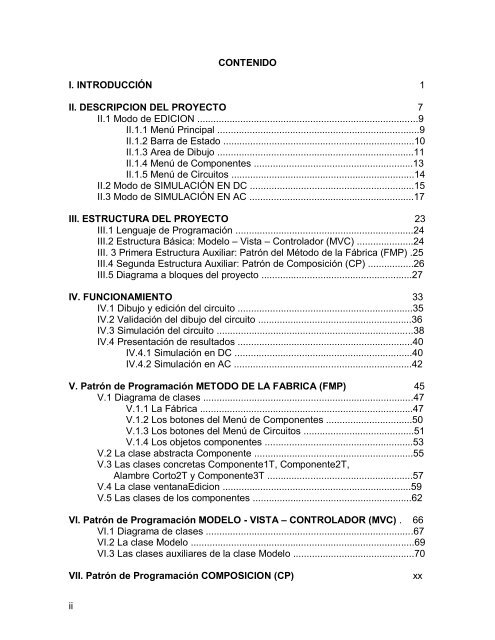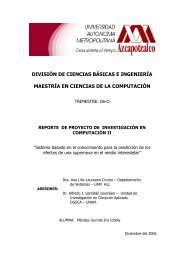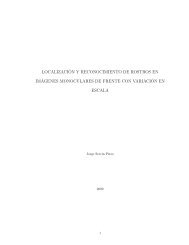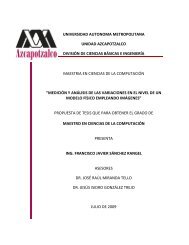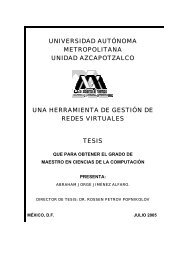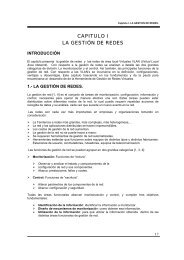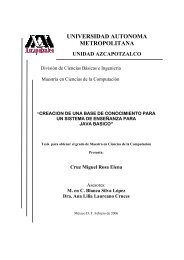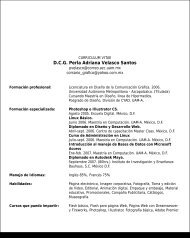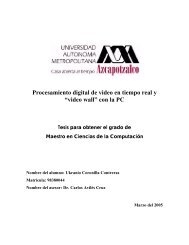Tesis Simulador Circuitos 3D.pdf - MaestrÃa en Ciencias de la ...
Tesis Simulador Circuitos 3D.pdf - MaestrÃa en Ciencias de la ...
Tesis Simulador Circuitos 3D.pdf - MaestrÃa en Ciencias de la ...
Create successful ePaper yourself
Turn your PDF publications into a flip-book with our unique Google optimized e-Paper software.
CONTENIDO<br />
I. INTRODUCCIÓN 1<br />
II. DESCRIPCION DEL PROYECTO 7<br />
II.1 Modo <strong>de</strong> EDICION ..................................................................................9<br />
II.1.1 M<strong>en</strong>ú Principal ...........................................................................9<br />
II.1.2 Barra <strong>de</strong> Estado .......................................................................10<br />
II.1.3 Area <strong>de</strong> Dibujo .........................................................................11<br />
II.1.4 M<strong>en</strong>ú <strong>de</strong> Compon<strong>en</strong>tes ...........................................................13<br />
II.1.5 M<strong>en</strong>ú <strong>de</strong> <strong>Circuitos</strong> ....................................................................14<br />
II.2 Modo <strong>de</strong> SIMULACIÓN EN DC .............................................................15<br />
II.3 Modo <strong>de</strong> SIMULACIÓN EN AC .............................................................17<br />
III. ESTRUCTURA DEL PROYECTO 23<br />
III.1 L<strong>en</strong>guaje <strong>de</strong> Programación ..................................................................24<br />
III.2 Estructura Básica: Mo<strong>de</strong>lo – Vista – Contro<strong>la</strong>dor (MVC) .....................24<br />
III. 3 Primera Estructura Auxiliar: Patrón <strong>de</strong>l Método <strong>de</strong> <strong>la</strong> Fábrica (FMP) .25<br />
III.4 Segunda Estructura Auxiliar: Patrón <strong>de</strong> Composición (CP) .................26<br />
III.5 Diagrama a bloques <strong>de</strong>l proyecto ........................................................27<br />
IV. FUNCIONAMIENTO 33<br />
IV.1 Dibujo y edición <strong>de</strong>l circuito .................................................................35<br />
IV.2 Validación <strong>de</strong>l dibujo <strong>de</strong>l circuito .........................................................36<br />
IV.3 Simu<strong>la</strong>ción <strong>de</strong>l circuito .........................................................................38<br />
IV.4 Pres<strong>en</strong>tación <strong>de</strong> resultados .................................................................40<br />
IV.4.1 Simu<strong>la</strong>ción <strong>en</strong> DC ..................................................................40<br />
IV.4.2 Simu<strong>la</strong>ción <strong>en</strong> AC ..................................................................42<br />
V. Patrón <strong>de</strong> Programación METODO DE LA FABRICA (FMP) 45<br />
V.1 Diagrama <strong>de</strong> c<strong>la</strong>ses ..............................................................................47<br />
V.1.1 La Fábrica ...............................................................................47<br />
V.1.2 Los botones <strong>de</strong>l M<strong>en</strong>ú <strong>de</strong> Compon<strong>en</strong>tes ................................50<br />
V.1.3 Los botones <strong>de</strong>l M<strong>en</strong>ú <strong>de</strong> <strong>Circuitos</strong> .........................................51<br />
V.1.4 Los objetos compon<strong>en</strong>tes .......................................................53<br />
V.2 La c<strong>la</strong>se abstracta Compon<strong>en</strong>te ...........................................................55<br />
V.3 Las c<strong>la</strong>ses concretas Compon<strong>en</strong>te1T, Compon<strong>en</strong>te2T,<br />
A<strong>la</strong>mbre Corto2T y Compon<strong>en</strong>te3T ......................................................57<br />
V.4 La c<strong>la</strong>se v<strong>en</strong>tanaEdicion ......................................................................59<br />
V.5 Las c<strong>la</strong>ses <strong>de</strong> los compon<strong>en</strong>tes ...........................................................62<br />
VI. Patrón <strong>de</strong> Programación MODELO - VISTA – CONTROLADOR (MVC) . 66<br />
VI.1 Diagrama <strong>de</strong> c<strong>la</strong>ses .............................................................................67<br />
VI.2 La c<strong>la</strong>se Mo<strong>de</strong>lo ...................................................................................69<br />
VI.3 Las c<strong>la</strong>ses auxiliares <strong>de</strong> <strong>la</strong> c<strong>la</strong>se Mo<strong>de</strong>lo .............................................70<br />
VII. Patrón <strong>de</strong> Programación COMPOSICION (CP)<br />
xx<br />
ii


